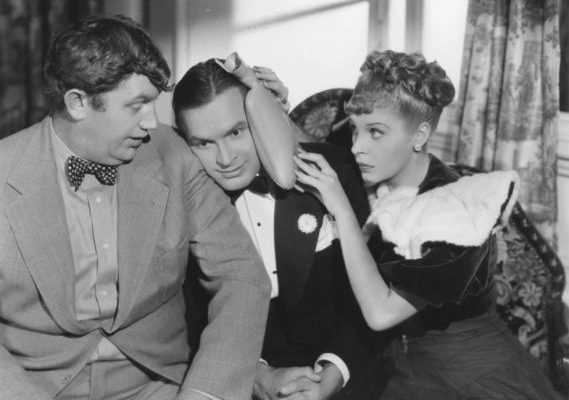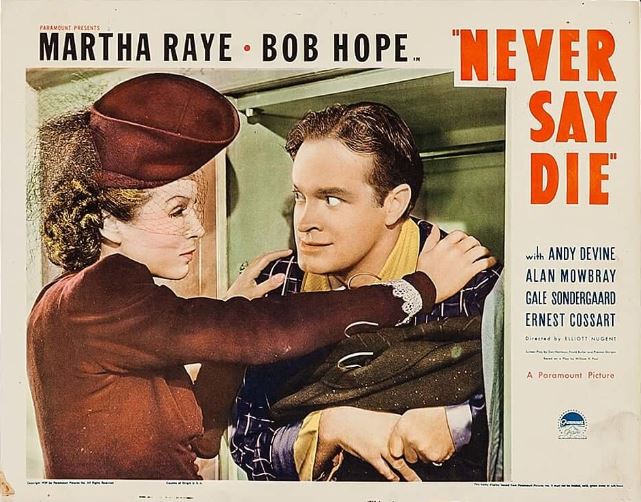Never Say Die (1939)

Toronto Film Society presented Never Say Die (1939) on Sunday, December 15, 1985 in a double bill with Auntie Mame as part of the Season 38 Sunday Afternoon Film Buffs Series “A”, Programme 4.
Production Company: Paramount. Producer: Paul Jones. Director: Elliott Nugent. Screenplay: Don Hartman, Frank Butler and Preston Sturges, based on a play by William H. Post. Photographer: Leo Tover. Editor: James Smith. Special Photographic Effects: Farciot Edouart. Song: “The Tra La La and the Com Pah Pah” by Ralph Rainger and Leo Robin.
Cast: Bob Hope (John Kidley), Martha Raye (Mickey Hawkins), Andy Devine (Henry Munch), Alan Mowbray (Prince Smirnov), Gale Sondergaard (Juno, The Adventuress), Sig Rumann (Poppa Ingleborg), Ernst Cossart (Jeepers), Paul Harvey (Jasper Hawkins), Frances Arms (Momma Ingleborg), Ivan Simpson (Kretsky), Monty Woolley (Dr. Schmidt), Foy Van Dolsen (Kretsky’s bodyguard), Christian Rub (The Mayor).
William H. Post’s play was originally made as a silent film in 1924 by Douglas MacLean. That show biz bible, Variety thought the 1939 remake, although offering some fine farcial and entertaining comedy, had a lot of missed opportunities for the stars. They gave their verbal bouquets to the supporting players. However, Bosley Crowther of the New York Times reviewed it as follows:
There is a certain backs-to-the-wall desperation implied in the title of Never Say Die the new rigadoon now clattering away at the Paramount which is not altogether inappropriate in a comedy of the sort that this one is. And you should certainly know the sort by now. With practically nothing behind them in the way of a story line, nothing that is, except a convenient point of departure. Bob and Martha just go in there swinging, throwing gags as fast as they can, sliding in and out of situations with the elegance of a roller-coaster and winding up out of breath and out of anything else to do. You can almost hear them at the end panting anxiously, “Did we make it?…And this time, one must admit, they did. …A good word for Never Say Die.
From an original script by Preston Sturges, the film was taken over by Hope’s regular writers, Don Hartman and Frank Butler and molded to fit the comic’s style, fast quips and frequent asides. However, the basic concept of a millionaire who, through a medical mix-up, comes to believe that he has a rare, terminal illness, remains as Sturges saw it. Other obvious Sturges touches are the parody of European health resorts, a philosophical butler, verbal vulgarities like “poppycock” and “go fry an egg”, and most tellingly, Kidley” (Hope’s) discovery of a new meaning of life through his “eminent” death (…nothing is important but living…).
During the 30’s and 40’s Preston Sturges rose to become the screen’s greatest writer-director. He was hailed as a comic genius and the films he created such as The Great McGinty, The Lady Eve, Sullivan’s Travels, The Palm Beach Story and Miracle of Morgan’s Creek won him a spectacular fortune and artistic acclaim.

The public’s perception of Martha Raye was formed in the 1936 film Rhythm On the Range when she belted out her trademark song “Mr. Paganini”. Following films took full advantage of this madcap image. However, her Annabella Bonheur in Monsieur Verdoux (1947) proved she had the ability and potential (if not he discipline) to become a brilliant comedienne. She was actually very attractive with, for Hollywood, the important qualities of having great legs and a 38 inch bust-line, plus having a fine singing voice. She was also earthy, fun-loving, with no pretensions and these were the qualities Paramount played up. The studio never “packaged” her to fully effective advantage and when they tried to tone her down or glamourize her in such films as Give Me A Sailor and Tropic Holiday (1938) and The Farmer’s Daughter (1940), it was too late. Audiences of the time were used to the slapstick Martha and her wild pranks. When the glamour image failed, the studio fired her. However, she worked on and off in films with extensive forays on the stage, and later television. She also did countless USO tours during World War II and in Vietnam. Martha’s motto must have been taken from the title of tonight’s film because she’s still at it doing television commercials as the “bigmouth”. Perhaps it’s wishful thinking but if Monsiur Verdoux had been a box office success, Martha Raye just might have become a major star.
Bob Hope, on the other hand, was and still is a major entertainer. He already had a successful stage and radio career before appearing in his first feature film, The Big Broadcast of 1938. His rendition of “Thanks for the Memory” with Shirley Ross, gave him a lifelong theme song. However, until his first real smash hit, and his sixth film, The Cat and the Canary (1939), tonight’s film was his best. In the ten or twelve years following The Cat and the Canary, Hope’s best and most successful pictures were made, pictures such as the “Road” films, Louisiana Purchase (1941), My Favourite Blonde (1942), The Princess and the Pirate (1944), Monsieur Beaucaire (1946), My Favorite Brunette (1947), The Paleface (1948), to name just a few. There were some gems in the 50’s, Fancy Pants (1950), The Lemon Drop Kid (1951), My Favorite Spy (1951), Son of Paleface (1952), Off Limits (1953), Casanova’s Big Night (1954) and two very good “bio-pics”, The Seven Little Foys (1955) and Beau James (1957). After that, with the exception of the highly entertaining The Facts of Life (1964) with Lucille Ball, forget it! His girl-chasing character was not very suitable for the mature, not to say middle-aged comic. It all seemed rather stale and a bit ludicrous, and audiences grew smaller and smaller. While still very popular on television and in personal appearances, Bob Hope no longer makes films and it’s too bad because in his prime he was unbeatable and provided us all with many, many hours of laughs and entertainment at the movies.
Notes by Barry Chapman










Leave a Reply